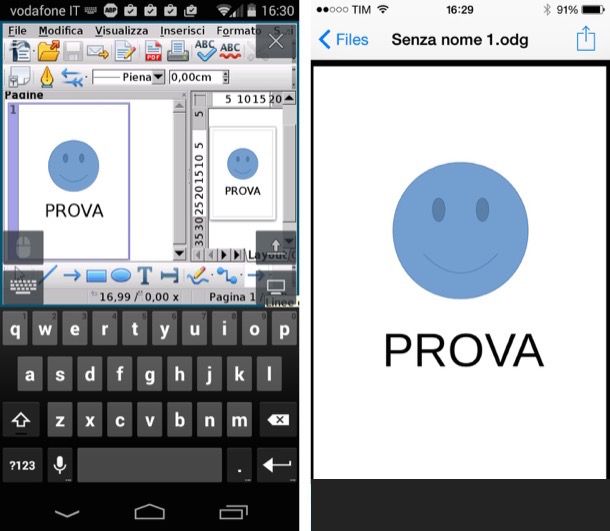Aprire File Odg Con Word List
Aprire File Odg Con Word Part. Webopedia's list of Data File Formats and File Extensions makes it easy to look through thousands of extensions and file formats.

Important: If you want to keep a Word version of your file, you must first save the file as a Word document, for example, in.docx file format, and then save it again in the OpenDocument Text (.odt) format. Click the File tab. Click Save As. Click Browse, and then select the location where you want to save your file. In the Save as type list, click OpenDocument Text. Give your file a name, and then save it. Learn more about the OpenDocument Format When you open or save documents in the OpenDocument Text (.odt) format, some formatting might be lost.
This is because of the different features and options, such as formatting, that OpenDocument Text applications and Word support. Babcock and wilcox boiler. For more information about the differences between the OpenDocument Text format and the Word format, see. Tips. Before sending a file to someone else, you might want to close the file and open it again to see what it looks like in OpenDocument Text (.odt) format. When you collaborate on a document shared between Word and another word processing application, such as Google Docs or OpenOffice.org Writer, think of writing (the words) and formatting (the look) as different tasks. Complete as much of the writing as possible without applying formatting to the text and save the formatting until the end.
This allows you to focus on the writing while minimizing the loss of formatting as you switch between the OpenDocument Text format and Word format. Important: If you want to keep a Word version of your file, you must first save the file as a Word document, for example, in.docx file format, and then save it again in the OpenDocument Text (.odt) format. Click the File tab.
Con Word List
Click Save As. Click Browse, and then select the location where you want to save your file.
In the Save as type list, click OpenDocument Text. Give your file a name, and then save it. Learn more about the OpenDocument Format When you open or save documents in the OpenDocument Text (.odt) format, some formatting might be lost.
This is because of the different features and options, such as formatting, that OpenDocument Text applications and Word support. For more information about the differences between the OpenDocument Text format and the Word format, see. Tips.
Before sending a file to someone else, you might want to close the file and open it again to see what it looks like in OpenDocument Text (.odt) format. When you collaborate on a document shared between Word and another word processing application, such as Google Docs or OpenOffice.org Writer, think of writing (the words) and formatting (the look) as different tasks. Complete as much of the writing as possible without applying formatting to the text and save the formatting until the end. This allows you to focus on the writing while minimizing the loss of formatting as you switch between the OpenDocument Text format and Word format. Important: If you want to keep a Word version of your file, you must first save the file as a Word document, for example, in.docx file format, and then save it again in the OpenDocument Text (.odt) format. Click the File tab.
Click Save As. In the Save as type list, click OpenDocument Text.
Name and save your file. Learn more about the OpenDocument Format When you open or save documents in the OpenDocument Text (.odt) format, some formatting might be lost. This is because of the different features and options, such as formatting, that OpenDocument Text applications and Word support.

For more information about the differences between the OpenDocument Text format and the Word format, see. Tips. Before sending a file to someone else, you might want to close the file and open it again to see what it looks like in OpenDocument Text (.odt) format. When you collaborate on a document shared between Word and another word processing application, such as Google Docs or OpenOffice.org Writer, think of writing (the words) and formatting (the look) as different tasks. Complete as much of the writing as possible without applying formatting to the text and save the formatting until the end.
This allows you to focus on the writing while minimizing the loss of formatting as you switch between the OpenDocument Text format and Word format. Important: If you want to keep a Word version of your file, you must first save the file as a Word document, for example, in.docx file format, and then save it again in the OpenDocument Text (.odt) format. Click the Microsoft Office Button, and click Save As.
Click OpenDocument Text. Learn more about the OpenDocument Format When you open or save documents in the OpenDocument Text (.odt) format, some formatting might be lost.
This is because of the different features and options, such as formatting, that OpenDocument Text applications and Word 2007 support. For more information about the differences between the OpenDocument Text format and the Word 2007 format, see. Tips. Before sending a file to someone else, you might want to close the file and open it again to see what it looks like in OpenDocument Text (.odt) format. When you collaborate on a document shared between Word and another word processing application, such as Google Docs or OpenOffice.org Writer, think of writing (the words) and formatting (the look) as different tasks. Complete as much of the writing as possible without applying formatting to the text and save the formatting until the end. This allows you to focus on the writing while minimizing the loss of formatting as you switch between the OpenDocument Text format and Word format.